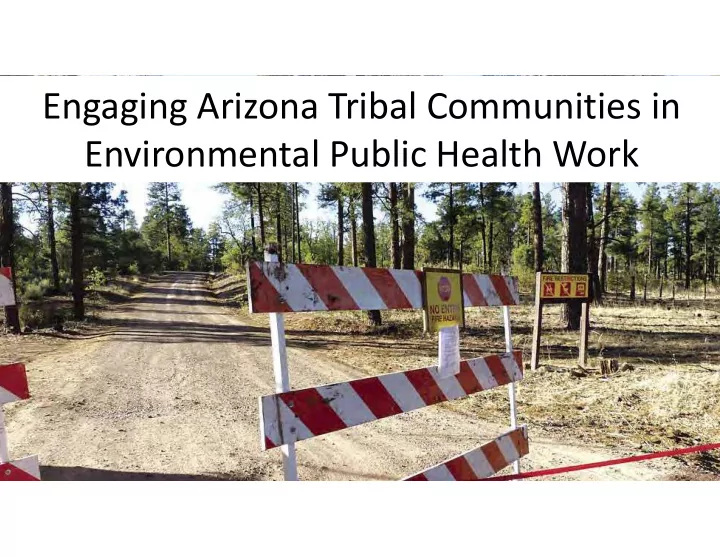

Engaging Arizona Tribal Communities in Environmental Public Health Work
Introduction • Dine’ (Navajo) • Clans – Mother: Oozie Ta’chii’nii – Father: Naakaaii Dine’ – Maternal Grandfather: Ma’ii deeshgizhii – Paternal Grandfather: Tsinijnne
Native American Liaison • Created Full Time in FY 2000 • 100% State General Funds • One Person Office • Division of Policy & Intergovernmental Affairs
Indian Health Care Community • 22 Tribes and Indian Nations • 3 Indian Health Service Area Offices • 3 Urban Indian Health Programs • Inter Tribal Council of Arizona
Demographics • 29% of Land Base • 5% of State Population: 296,529 (one race) – On Reservation – 162,119 (55%) – Off Reservation – 134,410 (45%) – Census 2010
EPHT Tribal Engagement Plan • Identified tribal representation as an important stakeholder group for EPHT • Conducted key informant interviews to better understand how EPHT has worked with tribes in other parts of the country • Developed engagement and evaluation plan
Goals to Build Partnerships • Increase tribal awareness of EPHT Program and representation on the EPHT Technical Advisory Group (TAG) • Ensure tribal needs and priorities are heard and accounted for • Identify tribal environmental health priorities • Establish partnerships and collaborations with tribes
Outreach • Sent invitations to participate in EPHT and TAG • Outreach to build network of tribal environmental health professionals • Attempted a communication needs assessment to identify environmental priorities
EPHT in Tribal Lands Meeting – 6/13/19 • Shared information on the EPHT program and projects • Facilitate discussion about environmental hazards that impact the health of tribal communities (e.g. air quality, water quality, extreme weather events) and how communities are addressing these hazards • Provided a networking opportunity for tribal, state, and government environmental health professionals
Participants
Takeaways: Healthy Homes and Places • Concerns over illegal burning of garbage causing cancer and air quality issues • Better access to home inspection reports • Partnerships to assess indoor air quality (mold, radon, heavy metals, ash, etc.)
Takeaways: Vector-borne Disease • Identified concerns and data needs: – Vector-borne surveillance for human cases and animal cases is important – Tick surveillance for RMSF – Mosquito surveillance for West Nile virus – Rabies prevention programs
Takeaways: Emergency Preparedness • Wildfire emergency response • Air quality south of the border • Illegal dumping – need data • Interest in ADEQ Flag Program
Meeting Summary • Tribal communities are invested in and want to be engaged in all phases of environmental health projects • Need to continue dialogue and pursue EPHT projects in tribal communities • Provide access to data previously unknown to tribal communities • Use data to apply for grants or policy development
Next Steps • Partner with a tribal community on an environmental health topic • Continue work addressing data needs and gaps identified by tribes • Connect and facilitate tribal partnerships and meetings to address environmental health concerns
Lessons Learned • Be culturally sensitive and supportive • Building relationships and partnerships takes time • Productive method of support involve providing resources, conducting tribal specific meetings, and offering technical assistance
Recommend
More recommend